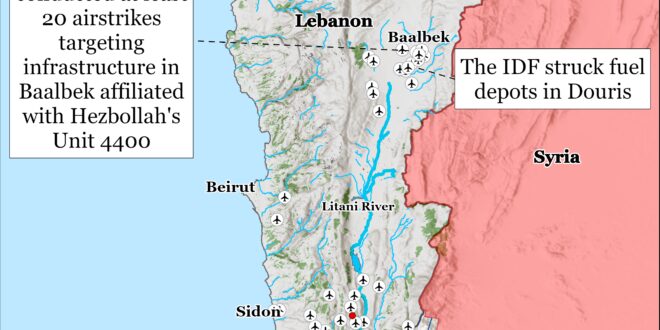Qassem hinted at a possible shift in Hezbollah policy that would allow a Lebanon ceasefire to be separated from Israeli operations in the Gaza Strip. The new secretary general was less absolute regarding a ceasefire in the Gaza Strip than Nasrallah had been before his death. Nasrallah had previously said that a ceasefire in Lebanon would have to be contingent on halting Israeli operations in the Gaza Strip. Qassem appeared less resolute by saying that Hezbollah would accept “appropriate” ceasefire conditions but insisted that “the basis for any negotiations is a ceasefire first.”[10] Qassem indicated on October 8 that the group may be open to a ceasefire that is not linked to the Gaza Strip.[11] Nasrallah had previously been very explicit that Hezbollah would not stop indirect fire attacks into Israel until the IDF withdrew from the Gaza Strip.[12] Nasrallah held this unambiguous position before Israel began ground operations in southern Lebanon, however. The shift in Hezbollah’s position may be a result of both new Hezbollah leadership and the escalation of a war that has temporarily degraded Hezbollah’s command, control, and logistical networks. Qassem said he believes that Hezbollah, not an international resolution, expelled Israel from Lebanon in 2006 and 2000, suggesting his reluctance to enter into a ceasefire agreement.[13]
Qassem expressed considerable skepticism that Israel would abide by a ceasefire agreement, citing what he sees as past Israeli violations of UNSCR 1701 and Israel’s vision for Lebanon. Qassem alleged that Israel regularly violated UNSCR 1701, but Hezbollah has violated the resolution since the end of the 2006 war by building massive military sites south of the Litani River that Israeli forces are now operating inside of Lebanon to destroy.[14] Qassem described Hezbollah’s activities in southern Lebanon as a “proactive defense” against an Israeli intent to “eliminate” the resistance and “our people in the region.”[15] A “proactive” Hezbollah defense including ground forces designed to attack Israel is a violation of UNSC Resolution 1701. He claimed that Israel always intended to invade Lebanon and that Hezbollah “harass[ment]” of northern Israeli towns with daily rocket and drone attacks did not cause Israel’s current operation.[16] This statement by Qassem is false. Israel’s stated war aim is to return residents of northern Israel to their homes under safe conditions.[17] Tens of thousands of Israeli civilians left northern Israel border villages and towns shortly after Hezbollah began attacking Israel with rockets, drones, and other systems on October 8, 2023.[18]
Qassem distanced himself and Hezbollah from Iran, stating that Hezbollah is not pursuing an Iranian project but is executing its plan to protect and liberate Lebanese land.[19] He praised Iran for its “financial, media, and political support” and the “heavy price” that it pays for that support and its stance on Palestine.[20] Emirati media cited an Iranian source that said that Qassem fled Lebanon on October 5 aboard the Iranian foreign minister’s plane.[21] CTP-ISW is unable to independently confirm this report. Qassem also thanked other Axis of Resistance groups for their support of Hezbollah and Palestine, singling out the Houthis and Iranian-backed Iraqi militias.[22] Qassem’s praise for these groups is particularly notable given that several Houthi and Iraqi fighters have died in southern Lebanon since the Israeli campaign accelerated in late September 2024.[23]
Israel’s retaliatory strikes on Iran on October 25 significantly degraded Iran’s integrated air defense system and made subsequent Israeli strikes on Iran easier and less risky. Senior US and Israeli officials confirmed that the IDF strikes rendered Iran’s S-300 air defense systems inoperable, likely by destroying the radars that the systems rely on.[24] The S-300 is the collective name for a number of individual platforms. Destroying the radars that the S-300 uses to engage targets, for example, would render the entirety of the S-300 system unable to engage air targets. The strikes also successfully targeted two Iranian Ghadir passive array detection radar sites, advertised as being capable of detecting ballistic missiles and stealth aircraft in Iranian airspace.[25] It is not clear how well or how reliably these passive array detection radars can detect stealth aircraft in particular. Israeli media reported on October 28 that Israel is planning to retaliate separately against Iran for the Lebanese Hezbollah attack that targeted Israeli Prime Minister Benjamin Netanyahu on October 19.[26] The damage to Iran’s air defenses has likely seriously degraded Iran’s ability to defend against further Israeli attacks.
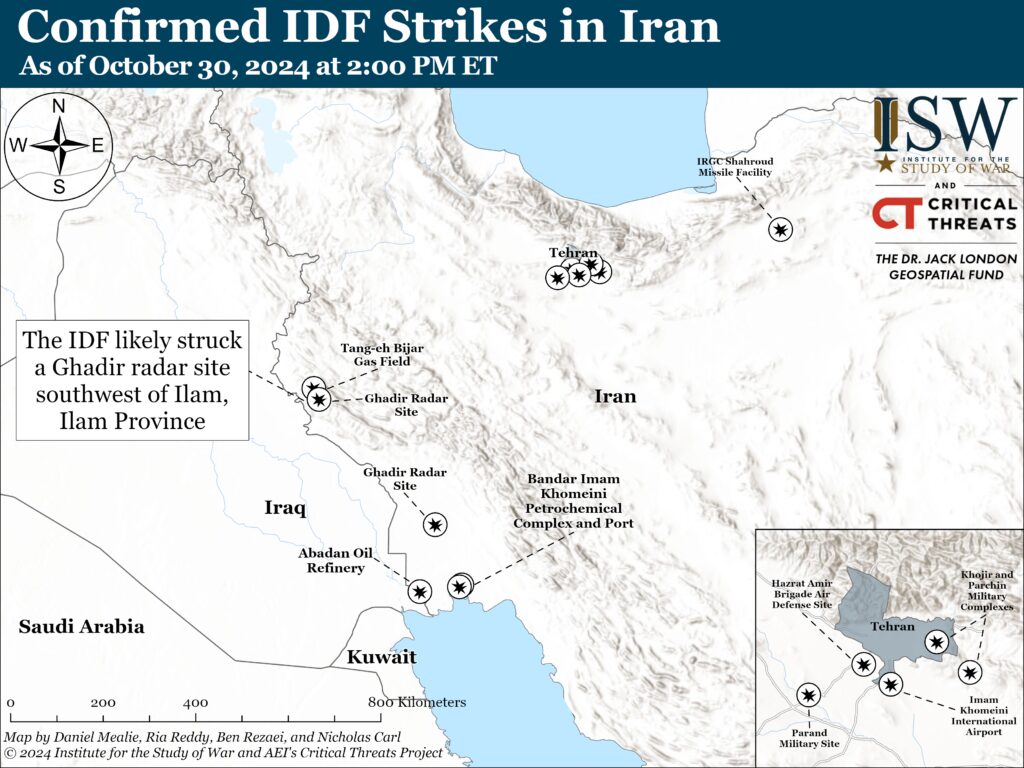
The IDF is signaling that it is preparing to end its initial phase of ground operations in southern Lebanon. IDF officials told senior Israeli officials that it is an opportune time to obtain a diplomatic solution to end fighting with Hezbollah in southern Lebanon and avoid a longer conflict in Lebanon during an Israeli cabinet meeting on October 29, according to unspecified Israeli officials.[27] The Israeli officials said that the IDF is “very close” to ending its initial phase of ground operations in Lebanese border villages.[28] This reporting is consistent with recent reports that the IDF Northern Command expects to finish its initial phase of ground operations in southern Lebanon within a few weeks.[29] Israel and Lebanon are reportedly currently “in advanced stages” of ceasefire negotiations, which would involve a 60-day ceasefire followed by negotiations for a new mechanism to supervise southern Lebanon.[30] Senior US officials Amos Hochstein and Brett McGurk will arrive in Israel on October 31 to meet with Israeli officials to discuss the most recent ceasefire proposal.[31]
Israeli movement to secure a ceasefire suggests that the IDF believes it has achieved the military objectives dictated to it by Israeli political leadership, not that the ground operation has “failed.” Israeli ground and air operations have degraded Radwan special operations forces (SOF) assets to eliminate the threat of a Hezbollah ground infiltration into Israel. The IDF began its ground operations in southern Lebanon to degrade Hezbollah’s capabilities to conduct an October 7-style offensive and direct fire attacks into northern Israel, supporting the stated Israeli war aim of returning Israeli civilians to the north. The IDF said that the Radwan forces aimed to “infiltrate Israeli territory and occupy [Israeli territory] near the northern border.”[32] Israeli operations along the Israel-Lebanon border have focused on removing Hezbollah Radwan SOF infrastructure that could have been used to launch ground attacks into Israel.[33] These raids have likely severely degraded if not destroyed Radwan infrastructure in border towns. The IDF recently announced that it “destroyed” Hezbollah’s ability to conduct a ground infiltration into Israel from Kfar Kila.[34] Israeli forces have destroyed at least seven major Radwan SOF sites during operations in southern Israel.[35]
The IDF Air Force also struck and killed Hezbollah’s Radwan SOF deputy commander Mustafa Ahmed Shahadi in the Nabatieh region of southern Lebanon on October 30.[36] The IDF said that Shahadi managed the Radwan Force’s combat plans in southern Lebanon.[37] Shahadi is the latest of at least ten Radwan SOF leaders that Israel has killed in Lebanon in 2024.[38] The IDF has also detained Radwan fighters during ground operations in southern Lebanon.[39]
The IDF continued to conduct clearing operations and seize terrain along the Lebanese border to disrupt Hezbollah artillery observers’ ability to support indirect rocket and mortar attacks into northern Israel.[40] Israeli armor advanced towards Khiam on October 28, which is located on hilly terrain that would enable Hezbollah to direct these types of attacks with a view of northern Israel.[41] Israeli forces are currently continuing clearing operations in Kfar Kila, Aitaroun, Dahyra, and Oum Touteh.[42]
Israeli Defense Minister Yoav Gallant assessed that IDF operations have destroyed around 80 percent of Hezbollah’s pre-October 7 rocket capabilities.[43] Gallant said that Hezbollah is not currently organized in a way that would allow it to fire large barrages of rockets at northern Israel.[44] Pre-war IDF estimates from 2016 suggested that Hezbollah may launch up to 1,500 rockets and missiles daily into northern Israel in the event of an Israel-Hezbollah war.[45] Hezbollah’s volume of rocket fire does not approach pre-war estimates of Hezbollah’s capabilities, although Israeli estimates have reported that Hezbollah’s daily average of fire into Israel is four times greater than the daily average before Israel’s ground operations.[46] CTP-ISW estimates that Hezbollah has launched a daily average of 75 rockets into northern Israel between October 22 and October 29.[47] This suggests that Israeli operations degraded Hezbollah’s rocket assets, which is a necessary step to remove the threat that Hezbollah poses to northern Israeli towns. An Israeli think tank estimated on October 28 that Hezbollah still likely retains up to 25,000 short-range rockets and up to 2,000 rockets and medium-range missiles.[48]
Key Takeaways:
Hezbollah: Qassem continued to attempt to obfuscate the reality that Hezbollah’s military forces are failing in Lebanon. Qassem alleged that Israel regularly violated UNSCR 1701, but Hezbollah has violated the resolution since the end of the 2006 war by building massive military sites south of the Litani River that Israeli forces are now operating inside of Lebanon to destroy.
Israeli Airstrikes Targeting Iran: Israel's retaliatory strikes on Iran on October 25 significantly degraded Iran's integrated air defense system and made subsequent Israeli strikes on Iran easier and less risky.
Ceasefire in Lebanon: The IDF is signaling that it is preparing to end its initial phase of ground operations in southern Lebanon. Israeli movement to secure a ceasefire suggests that the IDF believes it has achieved the military objectives dictated to it by Israeli political leadership, not that the ground operation has “failed.”
Israeli Ground Operations in Lebanon: The IDF continued to conduct clearing operations and seize terrain along the Lebanese border to disrupt Hezbollah artillery observers’ ability to support indirect rocket and mortar attacks into northern Israel.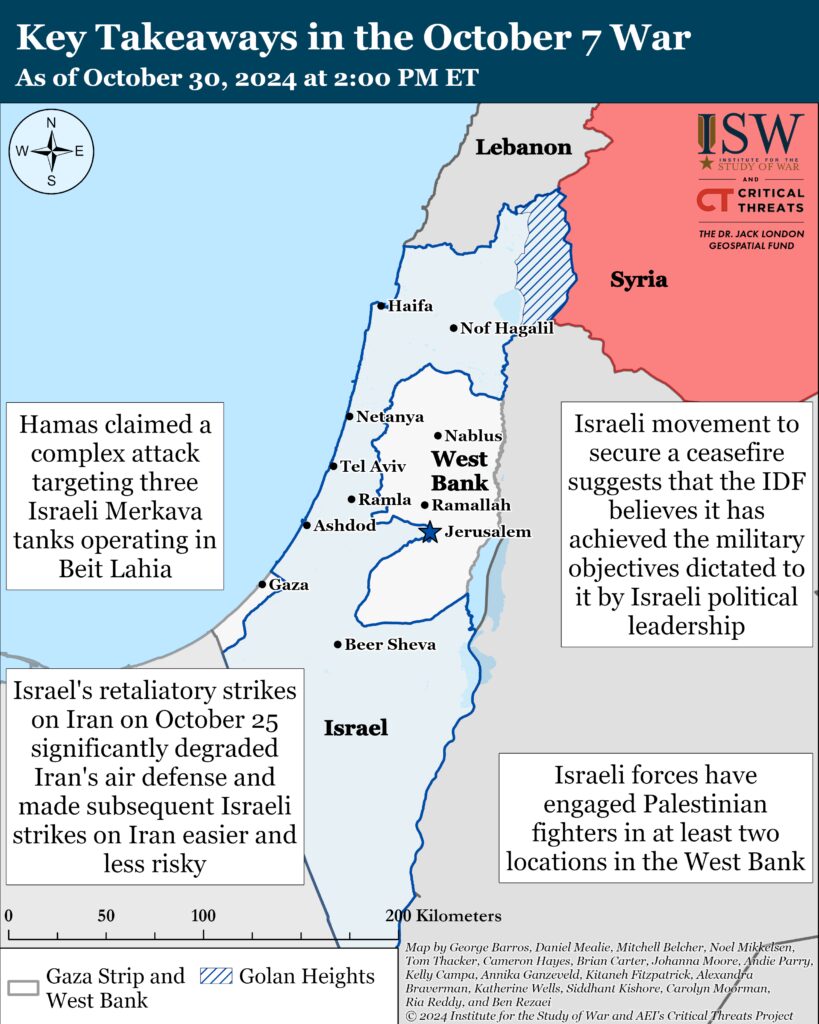
Gaza Strip
Axis of Resistance objectives:
Erode the will of the Israeli political establishment and public to sustain clearing operations in the Gaza Strip
Reestablish Hamas as the governing authority in the Gaza StripThe Hamas-run Gazan Health Ministry reported at least 93 Palestinians, including 25 children, were killed in an Israeli airstrike in Beit Lahia on October 29.[49] Gazan rescue and medical workers claimed that the Israeli airstrike hit a five-story apartment building where Palestinians were sheltering.[50] An unspecified IDF official cited by The Washington Post stated that Israeli forces identified a Hamas spotter on the roof of the building and that the strike was not intended to collapse the building.[51] A separate Israeli military source cited by CNN said that the building “may have been a ’Hamas gathering point.’”[52] The IDF reported that “the area was evacuated by the IDF and it is currently an active combat zone.”[53] The IDF added that it is aware of reported civilian casualties and is investigating the incident.
Hamas claimed a complex attack on October 30 targeting three Israeli Merkava tanks operating in Beit Lahia.[54] Hamas claimed its fighters detonated a “barrel bomb” and fired rocket-propelled grenades (RPGs) at the tanks.
The IDF 162nd Division has continued clearing operations in unspecified areas of Jabalia since CTP-ISW’s data cut off on October 29.[55] Israeli forces killed “dozens” of Palestinian fighters in airstrikes and ground engagements. The al Aqsa Martyrs’ Brigades—the self-proclaimed militant wing of Fatah—claimed a mortar attack targeting Israeli forces northeast of the “eastern cemetery” in Jabalia.[56]
The 252nd Division destroyed militia infrastructure and killed Palestinian fighters in the central Gaza Strip on October 30.[57] The IDF 252nd Division has operated around Nuseirat and Bureij refugee camps in the central Gaza Strip since October 17.[58] Palestinian Islamic Jihad (PIJ) claimed a mortar attack targeting a concentration of Israeli forces south of Juhor ad Dik.[59]
Palestinian militias claimed three indirect fire attacks targeting Israeli forces around the Netzarim Corridor on October 30. PIJ claimed multiple attacks targeting IDF command-and-control sites along the Netzarim Corridor.[60] PIJ, the Popular Front for the Liberation of Palestine, and the al Amoudi Brigade—a splinter group of the al Aqsa Martyrs’ Brigades—claimed combined rocket and mortar attacks targeting IDF command-and-control sites along the Netzarim Corridor.[61] PIJ and the al Aqsa Martyrs’ Brigades also conducted a combined rocket and mortar attack targeting Israeli forces near the Turkish Friendship Hospital on the Netzarim Corridor.[62]
The IDF Air Force conducted an airstrike on October 30 targeting Hamas and PIJ fighters operating in an unspecified area of the al Mawasi humanitarian zone, Khan Younis.[63] The IDF reported that Israeli forces took measures to reduce civilian casualties.[64]
The IDF 143rd Division has continued clearing operations in Rafah since CTP-ISW’s last data cut-off on October 29.[65] Israeli forces destroyed militia infrastructure and killed Palestinian fighters operating in the area. Palestinian militias have not claimed any attacks on Israeli forces in Rafah since CTP-ISW’s last data cut-off on October 29.
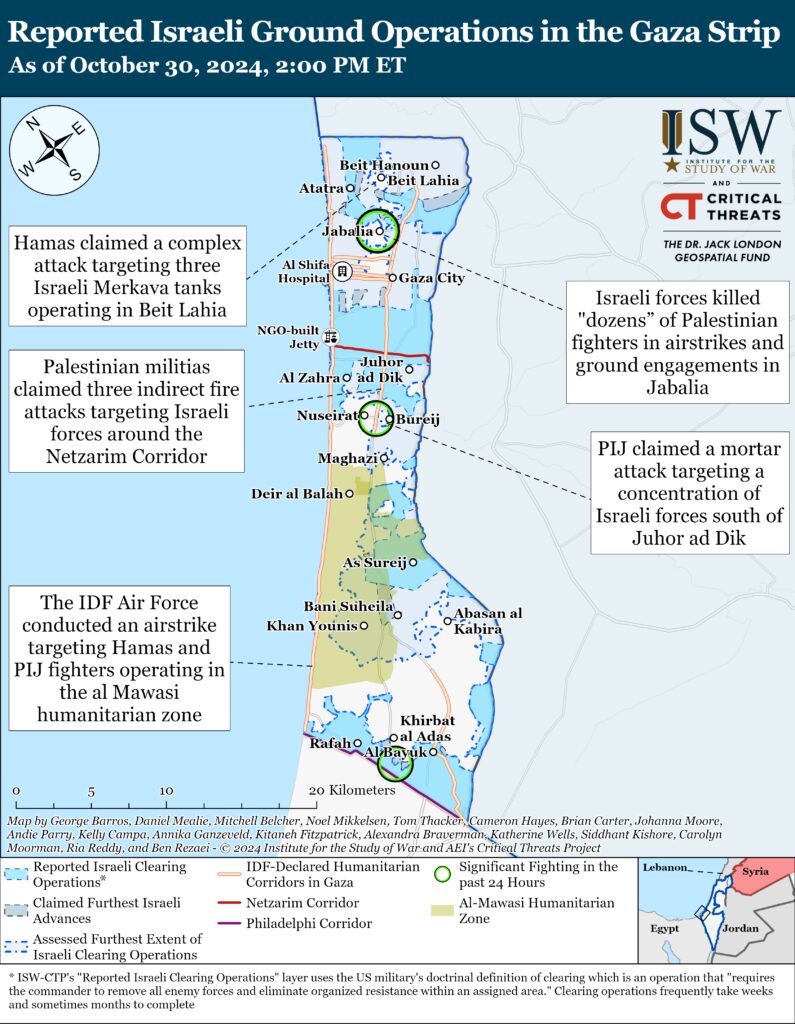
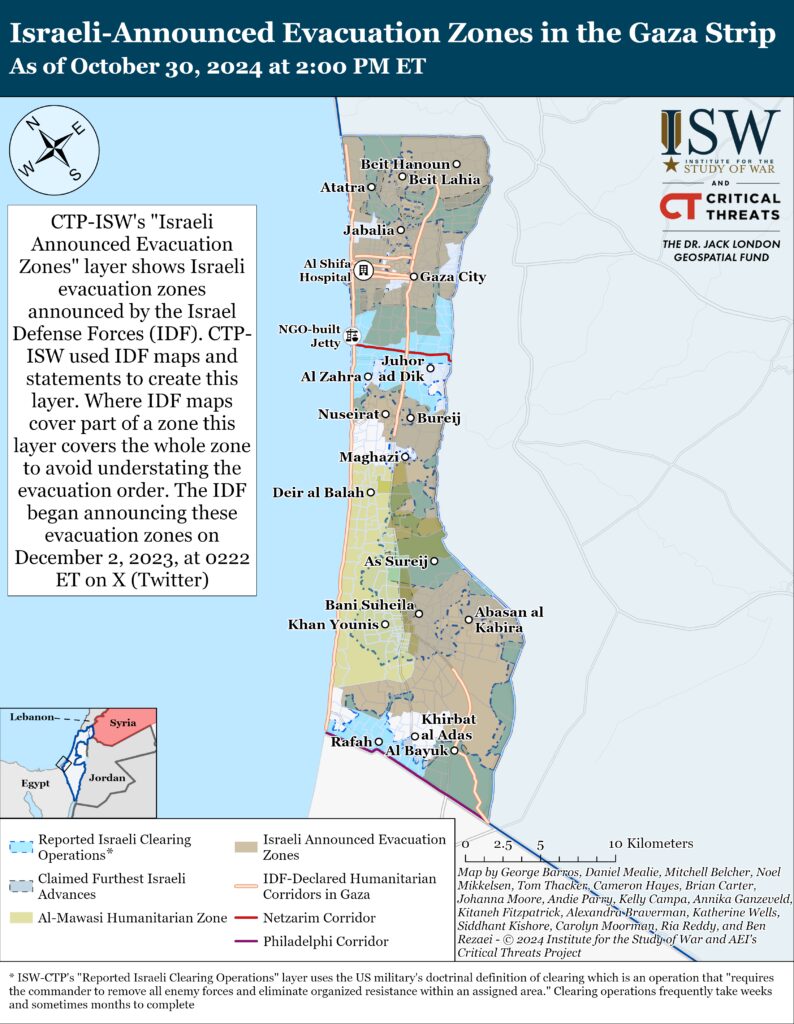
The United States envoy to the United Nations Linda Thomas-Greenfield stated during a UN Security Council session on October 29 that Israel must immediately address the “catastrophic humanitarian situation” in Gaza.[66] Thomas-Greenfield expressed concern with recent Israeli legislation banning UNRWA from operating in Israel and warned that there is “no alternative” mechanism by which to deliver food and humanitarian aid in the Gaza Strip. The Israeli parliament passed legislation on October 29 banning UNRWA from operating in Israel.[67] Israeli legislation appears to allow UNRWA to continue operating within the Gaza Strip and the West Bank.[68] Netanyahu’s office released a statement after the legislation was passed stating that Israel will continue to work with international partners to deliver aid to the Gaza Strip.[69] The United States sent a letter to Israeli officials on October 13 warning that the Biden administration would be forced to take unspecified steps, implying the withholding of military aid to Israel, if humanitarian aid was not delivered to non-combatants in the Gaza Strip.[70]
West Bank
Axis of Resistance objectives:
Establish the West Bank as a viable front against IsraelHamas released a statement on October 29 calling upon Palestinians in the West Bank to “confront” Israeli settlers due to “escalation of settler crimes” in the West Bank.[71] Senior Hamas official Mahmoud Mardawi claimed that attacks by Israeli settlers have reached “unprecedented levels” and Palestinians in the West Bank must escalate “resistance of all forms.” Hamas’ statement comes after Israeli settlers fired small arms targeting Palestinian Authority (PA) security forces near the Israeli settlement of Havat Gilad in the West Bank on October 29.[72] The shooting incident injured two PA security officers.[73]
Israeli forces have engaged Palestinian fighters in at least two locations in the West Bank since CTP-ISW’s last data cut-off on October 29.[74] The al Aqsa Martyrs’ Brigades fired small arms and detonated improvised explosive devices targeting Israeli forces operating in Nablus and Qalqilya.[75] The Palestinian Islamic Jihad (PIJ) fired small arms targeting the IDF Jalama checkpoint in the northern West Bank.[76]
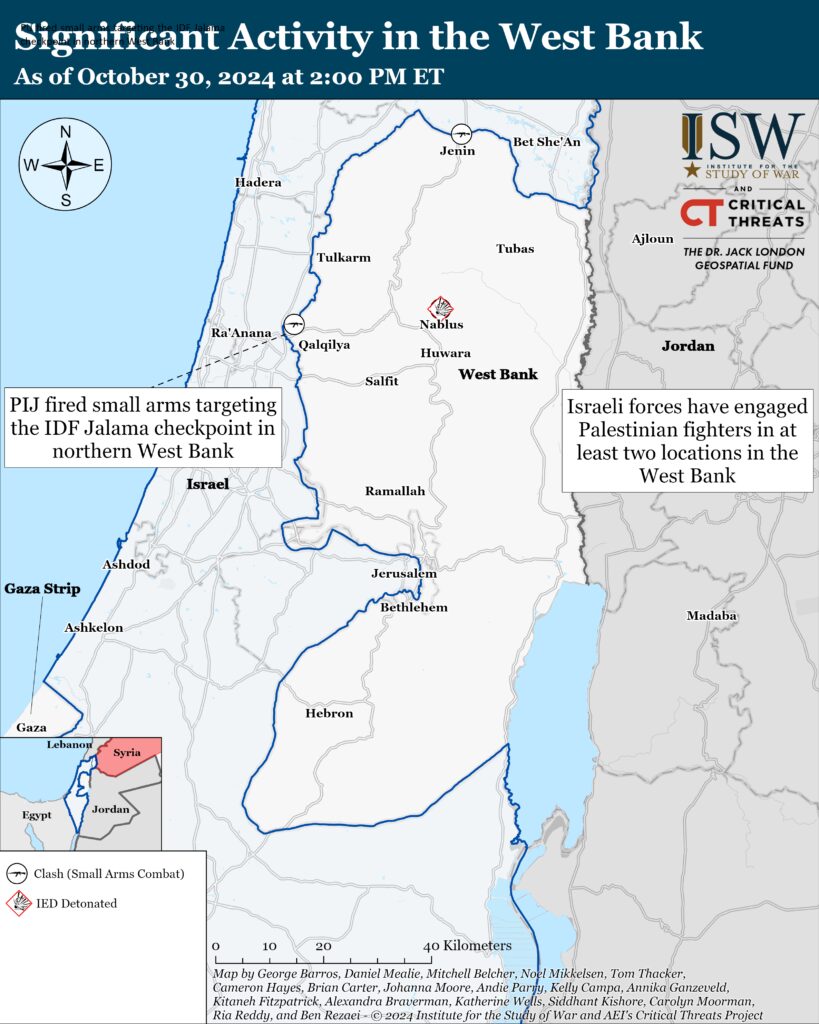
Northern Israel and Lebanon
Lebanese Hezbollah objectives:
End Israeli operations in the Gaza Strip
Survive the October 7 War as a capable political and military organization with control over LebanonHezbollah claimed its highest rate of attacks targeting Israeli forces since the Israeli ground operation began. Hezbollah has claimed 15 separate rocket attacks targeting Israeli forces operating south of Khiam since CTP-ISW’s last data cut-off on October 29.[77] The IDF advanced at least four kilometers into southern Lebanon towards the southern outskirts of Khiam on October 29.[78] This advance was the deepest advance into Lebanon since ground operations began on October 1.[79] The high number of rocket attacks is consistent with Hezbollah’s stated tactic of avoiding direct engagements with Israeli forces and attacking advancing Israeli forces from longer ranges.[80] It is unclear if Israeli forces are directly engaging Hezbollah fighters in Khiam yet. It is notable that Hezbollah fighters near Khiam are claiming such a high volume of rocket attacks targeting Israeli forces in this area, particularly considering that Hezbollah attack rates have been low during the IDF’s other advances in southern Lebanon.
Hezbollah-affiliated sources reported that Israeli forces fired small arms targeting unspecified targets near the town of Shebaa, Hasbaya District, on October 30.[81] The correspondent also said that IDF artillery shelled several neighborhoods in the town.[82] Hezbollah fired three barrages of rockets targeting Israeli soldiers located at Shebaa Gate.[83]
Israeli forces demolished an observation tower west of al Amra in southeastern Lebanon, near the border with Metula.[84] Commercially available satellite imagery captured on October 30 shows flattened terrain near the observation tower, indicating that Israeli tanks or bulldozers operated near the observation tower overlooking Metula.[85] Hezbollah has reported several engagements with Israeli forces in al Amra since October 28.[86]
The IDF 91st Division continued operations in Hula on October 30. Geolocated footage posted on October 30 shows Israeli forces conducting a controlled detonation of buildings in eastern Hula.[87] The 91st Division is also operating in Kfar Kila.[88] The IDF reported that the 91st Division continued to destroy underground shafts, locate weapons, and kill fighters.[89] Israeli forces located anti-aircraft missiles and maps that showed “firing lines” towards Israeli territory.[90] The IDF 226th Paratroopers Brigade (Res.) killed Hezbollah fighters who fired at Israeli forces and located combat equipment in the area.[91]
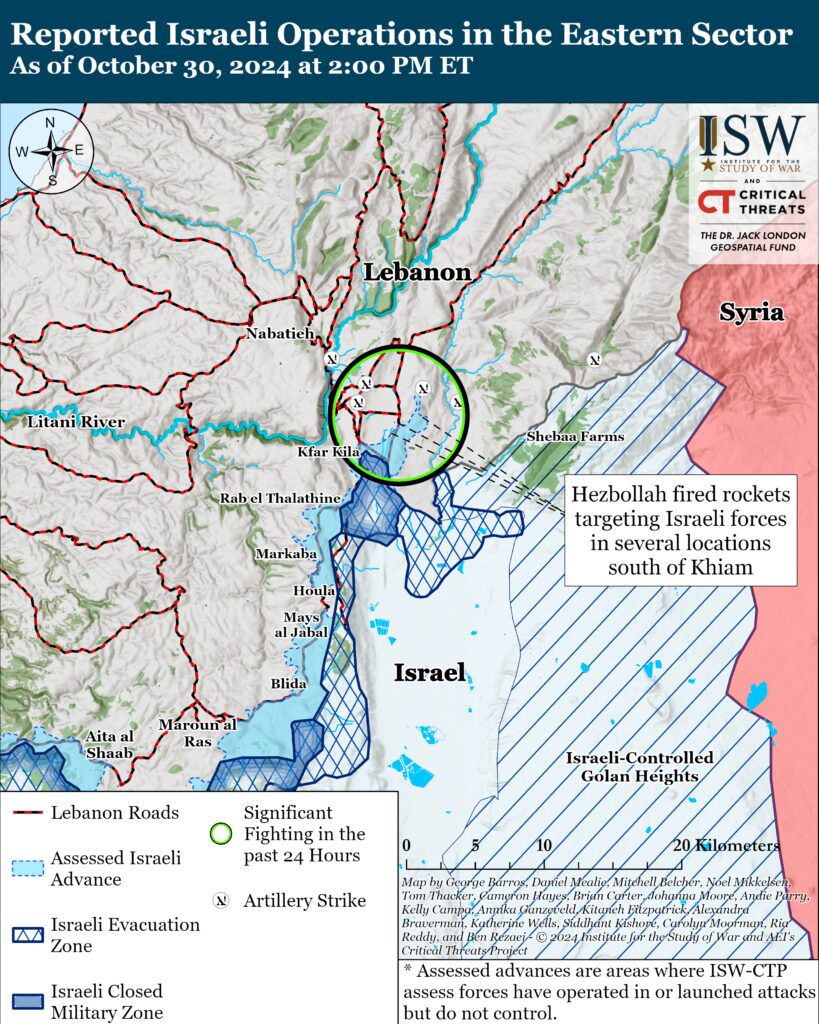
The IDF 146th Division continued clearing operations in southwestern Lebanon on October 30. The 146th Division attacked dozens of Hezbollah targets, such as weapons, anti-tank positions, and other infrastructure.[92] Geolocated footage posted on October 29 shows Israeli forces conducting controlled detonations of buildings in Oum Touteh, northwestern Yarine, and western Marwahin.[93] The IDF Air Force struck cells of Hezbollah fighters.[94]
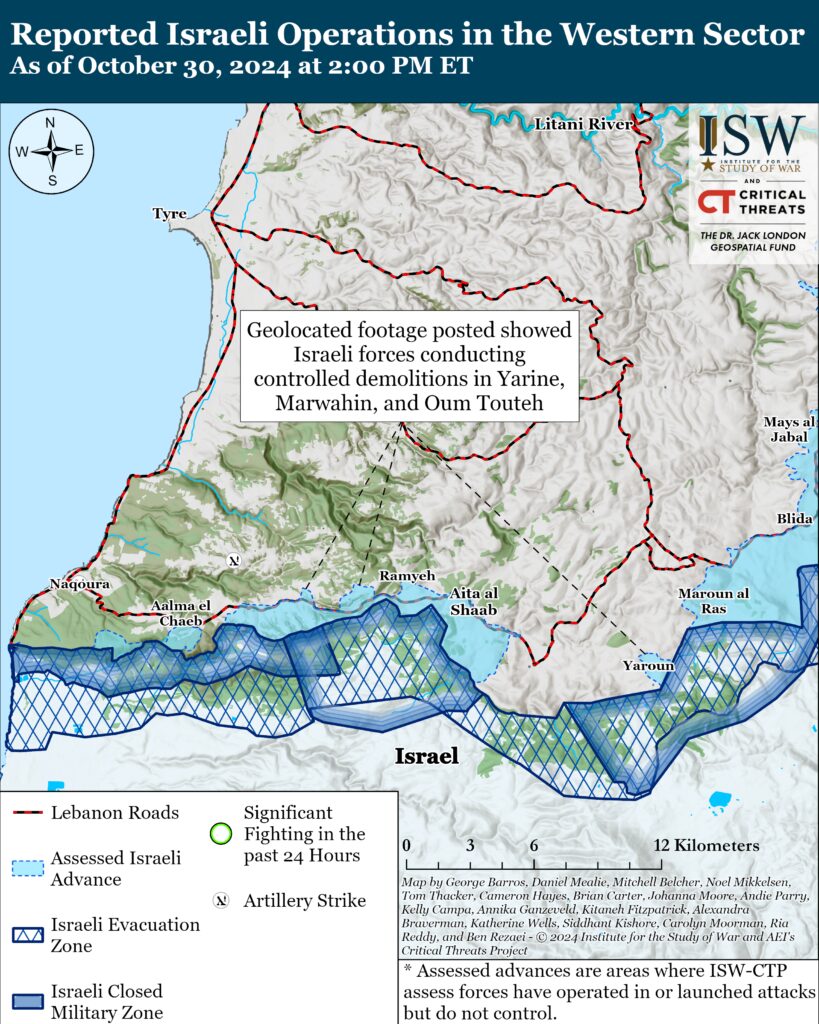
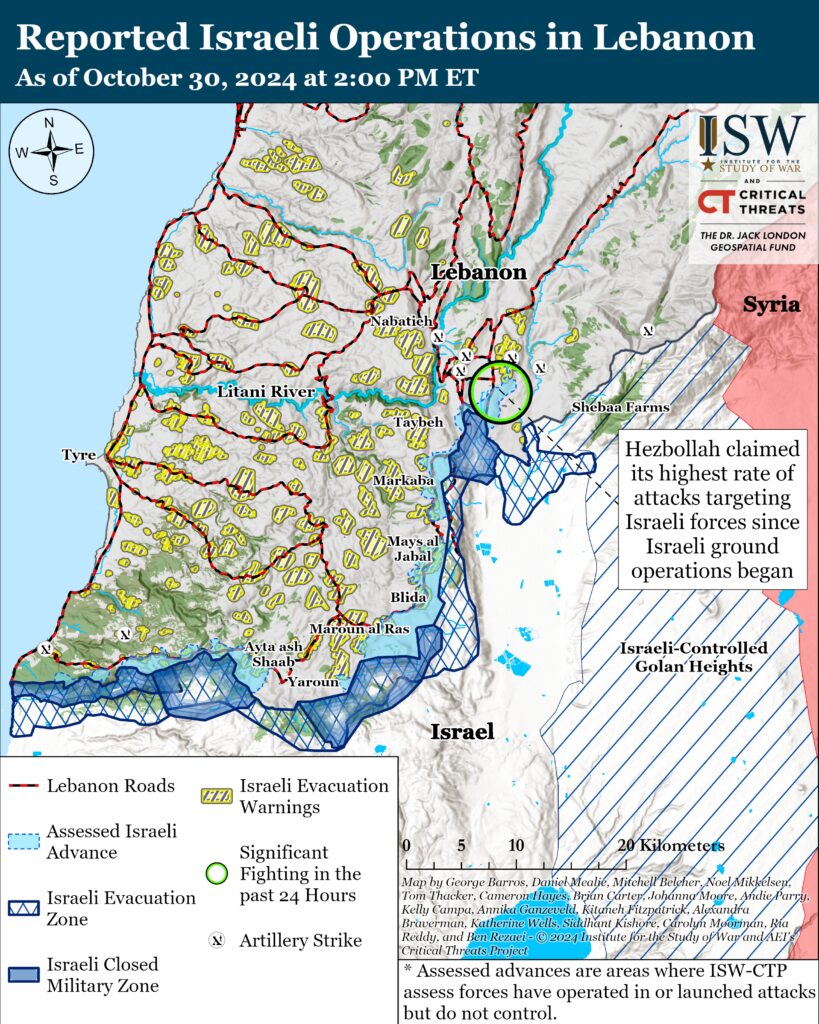
The IDF Air Force struck at least 20 targets in Baalbek, northeastern Lebanon, on October 30 to disrupt Hezbollah’s ability to transfer weapons from Syria and Iran to forces in Lebanon.[95] Baalbek is the Bekaa Valley’s largest city and has a population of over 80,000 residents.[96] The IDF said it struck fuel infrastructure located in military compounds affiliated with Hezbollah’s Unit 4400.[97] Hezbollah Unit 4400 is responsible for the transfer of funds and weapons from Iran to Hezbollah.[98] The IDF also struck at least 19 other sites in and near Baalbek, including Ain Bourday, Bednayel, Aamachki, and several neighborhoods in Baalbek.[99] The IDF Air Force has consistently struck targets near the Lebanon-Syria border to interdict Hezbollah weapon transfers and degrade Unit 4400’s infrastructure.[100]
The Lebanese Health Ministry reported that Israeli strikes in the Baalbek area killed at least 19 people.[101] The IDF’s October 30 strikes targeting sites in Baalbek follow its heavy airstrikes a day prior in the Bekaa Valley that killed at least 60 people.[102]
The IDF Air Force struck over 100 Hezbollah targets across Lebanon in the past day, including rocket launchers that attacked northern Israel on October 29.[103]
The IDF likely conducted airstrikes targeting an Iranian-backed militia site and an unspecified site in southwestern Syria on October 29.[104] The airstrikes struck an Iranian-backed militia site in Quneitra Governorate and an unspecified site in Tal al Jabiyah, western Daraa Governorate.[105]
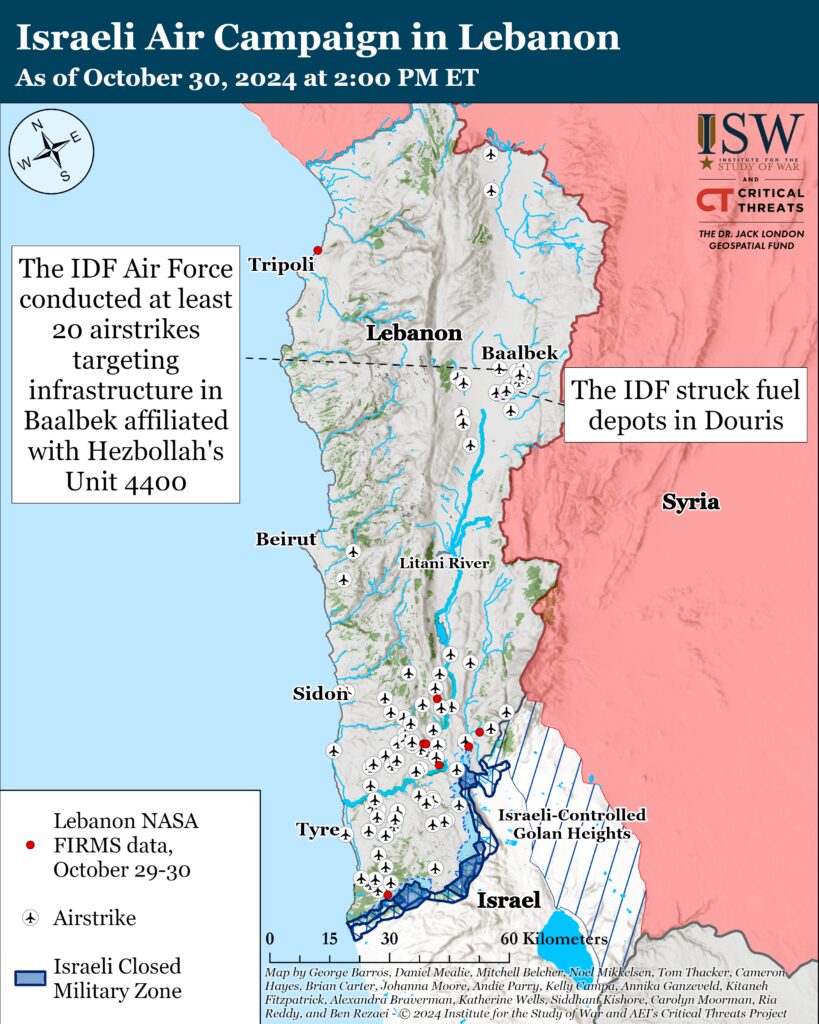
This map illustrates individual Israeli air strikes based on local Lebanese reporting. This map depicts strikes reported from 2:00pm ET on October 29 to 2:00pm ET on October 30. This map is not exhaustive. CTP-ISW cannot independently verify the locations of Israeli strikes.
Hezbollah has conducted at least 19 attacks into Israel since CTP-ISW’s last data cutoff on October 30.[106] Hezbollah fighters launched drones targeting IDF personnel in Shtula, Israel, which is adjacent to where Israeli forces are conducting clearing operations in the Lebanese town of Aita al Shaab.[107] The IDF identified three drones that crossed from Lebanon into Israel.[108] The IDF intercepted one drone but indicated that it had lost track of the other two in Western Galilee.[109] The IDF’s Home Front Command announced that the Air Force intercepted the drones more than an hour after the drones were initially detected.[110] The IDF also reported that a surface-to-surface missile was launched from Lebanon to Israel, but it fell apart in mid-air.[111]
Hezbollah also launched attacks targeting IDF infrastructure as part of Hezbollah’s “Khaybar series of operations” in response to the death of Hassan Nasrallah.[112] Hezbollah fired drones and rockets targeting the Ein Shemer Base, the IDF’s air defense and regional brigade base east of Hadera.[113] Hezbollah also launched drones and rockets targeting the IDF Northern Command’s Ellakim camp south of Haifa and the IDF’s Sharaga base north of Acre.[114] Hezbollah fighters fired rockets targeting the IDF’s Adam Camp southeast of Tel Aviv.[115] Hezbollah launched drones targeting Tirat al Carmel base in southern Haifa.[116][117]
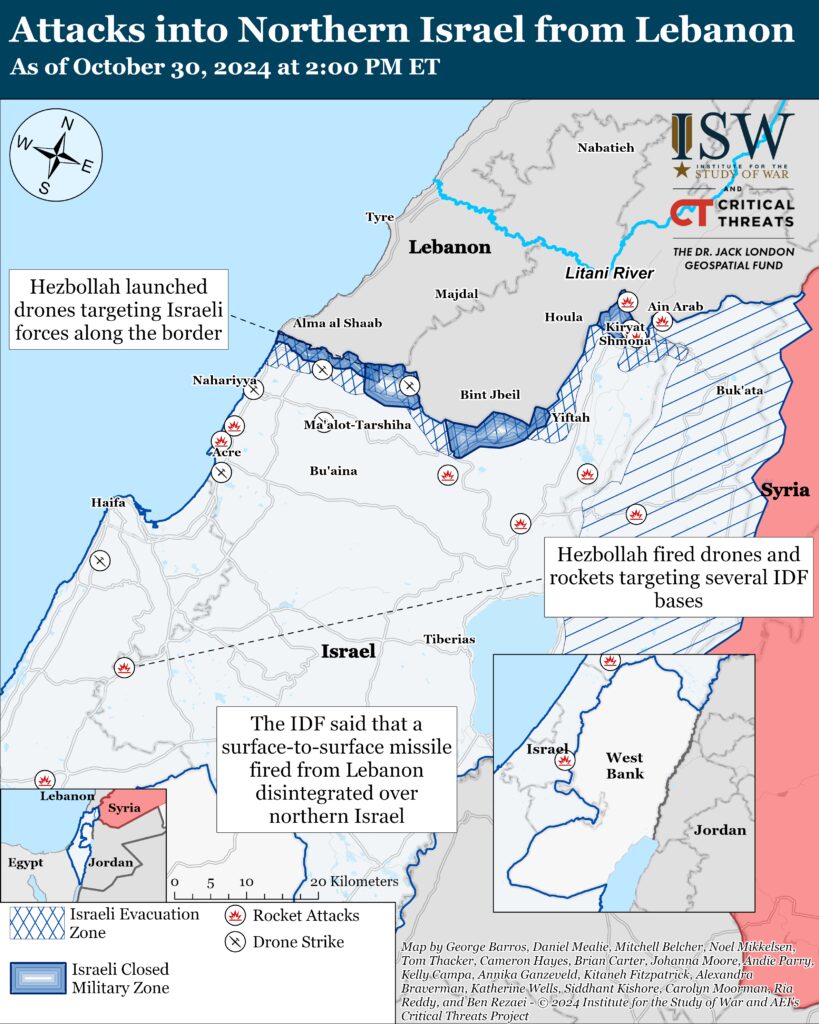
Iran and the Axis of Resistance
US Central Command (CENTCOM) Commander General Michael Kurilla traveled to Israel on October 30 to discuss joint US and Israeli preparations for a possible Iranian response to Israel’s recent strikes on Iran.[118] US officials told Israeli media ahead of the visit that Kurilla will engage with Israeli counterparts and US personnel in Israel.[119]
A Russian warship evacuated a senior Iranian IRGC Quds Force commander Brigadier General Abdolreza Shahlai from Hudaydah, Yemen, on an unspecified date in April 2024, according to the Wall Street Journal.[120] Shahlai is an IRGC commander responsible for Iran’s support to the Houthis in Yemen.[121] Shahlai directed the initial Houthi attacks targeting vessels around the Gulf of Aden and the Red Sea in October 2023, according to a Bloomberg report in March 2024.[122] The Wall Street Journal report did not specify when Russia supported Shahlai‘s evacuation from Yemen in April. Iran launched a drone and missile attack on Israel on April 13, and Israel in turn vowed to retaliate for the attack.[123] Shahlai may have fled Yemen after April 13 to avoid Israeli targeting.
Shahlai is a very senior IRGC Quds Force commander responsible for the deaths of US servicemembers and planning terrorist attacks on US soil. Shahlai planned an attack targeting a US base in Karbala, Iraq, in 2007 in which Asaib Ahl al Haq fighters kidnapped and executed four US servicemembers.[124] Shahlai was also sanctioned for providing weapons to Iranian-backed Iraqi militias to conduct attacks targeting US and Iraqi forces throughout Iraq.[125] Shahlai, as the commander of the IRGC Quds Force’s external operations wing, also planned a terrorist attack in Washington, DC, in 2011 that attempted to assassinate the Saudi Ambassador to the United States.[126]
An unspecified source close to the Islamic Resistance in Iraq told Iraqi media on October 29 that the Islamic Resistance in Iraq plans to double its rate of attacks targeting Israel in November 2024.[127] The Islamic Resistance in Iraq is a coalition of Iranian-backed Iraqi militias. The source claimed that the Islamic Resistance in Iraq increased its rate of attacks targeting Israel by 30 percent in October 2024. CTP-ISW recorded that the Islamic Resistance in Iraq increased its rate of attacks by approximately 106 percent between September and October 2024, claiming 31 attacks in September and 64 attacks in October thus far. The source also claimed that Israel failed to intercept 65 percent of the drones that the Islamic Resistance in Iraq has fired at Israel.[128] CTP-ISW cannot verify this claim, although the IDF has repeatedly intercepted drones launched from Iraq toward Israel in recent months.[129]

The Islamic Resistance in Iraq claimed a drone attack targeting an unspecified “vital target” in northern Israel on October 29.[130] Israeli media and officials have not commented on the attack at the time of this writing.
A member of the Shia Coordination Framework, which is a loose coalition of Iranian-backed Iraqi political parties, claimed on October 28 that Israel’s use of Iraqi airspace to conduct strikes into Iran on October 25 could “accelerate” discussions to remove US forces from Iraq.[131] The Shia Coordination Framework member, Ali al Fatlawi, claimed that the United States “allowed” Israel to “penetrate” Iraqi airspace to conduct the strikes into Iran.[132] Fatlawi emphasized that the Iraqi federal government must expel US forces from Iraq to restore its “control” over Iraqi airspace.
The Iranian parliament approved a bill on October 30 that allows the government to increase its assets in the International Monetary Fund (IMF).[133] Central Bank of Iran Governor Mohammad Reza Farzin separately stated that Iran plans to increase its capital in the IMF by approximately $1.783 billion.[134] The chairman of the Parliamentary Economic Committee claimed that failure to participate in this capital increase could result in losing Iran’s seat on the IMF board.[135]
The Iran Update provides insights into Iranian and Iranian-sponsored activities abroad that undermine regional stability and threaten US forces and interests. It also covers events and trends that affect the stability and decision-making of the Iranian regime. The Critical Threats Project (CTP) at the American Enterprise Institute and the Institute for the Study of War (ISW) provides these updates regularly based on regional events.
CTP-ISW defines the “Axis of Resistance” as the unconventional alliance that Iran has cultivated in the Middle East since the Islamic Republic came to power in 1979. This transnational coalition is comprised of state, semi-state, and non-state actors that cooperate to secure their collective interests. Tehran considers itself to be both part of the alliance and its leader. Iran furnishes these groups with varying levels of financial, military, and political support in exchange for some degree of influence or control over their actions. Some are traditional proxies that are highly responsive to Iranian direction, while others are partners over which Iran exerts more limited influence. Members of the Axis of Resistance are united by their grand strategic objectives, which include eroding and eventually expelling American influence from the Middle East, destroying the Israeli state, or both. Pursuing these objectives and supporting the Axis of Resistance to those ends have become cornerstones of Iranian regional strategy.
 Eurasia Press & News
Eurasia Press & News
